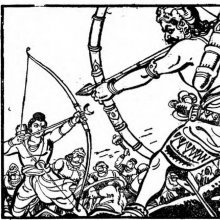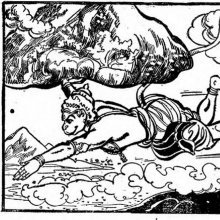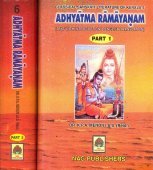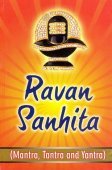Indrajit, Indra-jit, Indrajīt: 17 definitions
Introduction:
Indrajit means something in Buddhism, Pali, Hinduism, Sanskrit, Jainism, Prakrit. If you want to know the exact meaning, history, etymology or English translation of this term then check out the descriptions on this page. Add your comment or reference to a book if you want to contribute to this summary article.
Images (photo gallery)
In Hinduism
Purana and Itihasa (epic history)
Source: archive.org: Puranic EncyclopediaIndrajit (इन्द्रजित्).—Rāvaṇa’s son, Meghanāda. Genealogy. Descended from Viṣṇu thus:—Viṣṇu,-Brahmā—Pulastya—Viśravas—Rāvaṇa—Meghanāda (Indrajit). (See full article at Story of Indrajit from the Puranic encyclopaedia by Vettam Mani)
Source: Cologne Digital Sanskrit Dictionaries: The Purana Index1a) Indrajit (इन्द्रजित्).—A son of Rāvaṇa, killed in the Lanka war.*
- * Bhāgavata-purāṇa IX. 10. 18; Brahmāṇḍa-purāṇa III. 6. 6.
1b) A son of Danu.*
- * Matsya-purāṇa 6. 19; Vāyu-purāṇa 68. 6.
1c) A tīrtha near Garjanam on the Narmadā.*
- * Matsya-purāṇa 190. 3.

The Purana (पुराण, purāṇas) refers to Sanskrit literature preserving ancient India’s vast cultural history, including historical legends, religious ceremonies, various arts and sciences. The eighteen mahapuranas total over 400,000 shlokas (metrical couplets) and date to at least several centuries BCE.
Kavya (poetry)
Source: Wisdom Library: KathāsaritsāgaraIndrajit (इन्द्रजित्) is the name of Rāvaṇa’s son, according to the Kathāsaritsāgara, chapter 121. Accordingly, “... in course of time that son of Rāvaṇa, who was rightly named Indrajit, carried off the young deer from heaven and took it to his own city Laṅkā. And after a further period had elapsed—Rāvaṇa and Indrajit having been slain by the heroes Rāma and Lakṣmaṇa, to avenge the carrying off of Sītā...”.
The Kathāsaritsāgara (‘ocean of streams of story’), mentioning Indrajit, is a famous Sanskrit epic story revolving around prince Naravāhanadatta and his quest to become the emperor of the vidyādharas (celestial beings). The work is said to have been an adaptation of Guṇāḍhya’s Bṛhatkathā consisting of 100,000 verses, which in turn is part of a larger work containing 700,000 verses.

Kavya (काव्य, kavya) refers to Sanskrit poetry, a popular ancient Indian tradition of literature. There have been many Sanskrit poets over the ages, hailing from ancient India and beyond. This topic includes mahakavya, or ‘epic poetry’ and natya, or ‘dramatic poetry’.
Vastushastra (architecture)
Source: Brill: Śaivism and the Tantric Traditions (architecture)Indrajit (इन्द्रजित्) refers to one of the deities to be installed in the ground plan for the construction of houses, according to the Bṛhatkālottara, chapter 112 (the vāstuyāga-paṭala).—The plan for the construction is always in the form of a square. That square is divided into a grid of cells (padas). [...] Once these padas have been laid out, deities [e.g., Indrajit] are installed in them. In the most common pattern 45 deities are installed.

Vastushastra (वास्तुशास्त्र, vāstuśāstra) refers to the ancient Indian science (shastra) of architecture (vastu), dealing with topics such architecture, sculpture, town-building, fort building and various other constructions. Vastu also deals with the philosophy of the architectural relation with the cosmic universe.
General definition (in Hinduism)
Source: Apam Napat: Indian MythologyIndrajit was the son of Ravana, the demon-king of Lanka, and his queen Mandodhari. When he was born, he roared like the thunder in the clouds and was given the name of Megha-natha (lord-of-clouds). He performed rigorous penances and obtained many boons from Brahma. He then led the armies of Ravana against the Devas and conquered Indra, their king. From that day, he was known as Indrajit (conqueror-of-Indra).
He was slain by Laxmana, the younger brother of Rama.
Source: WikiPedia: Hinduism
1) Indrajit, a warrior mentioned in the Indian epic Ramayana, was the son of the Lankan king Ravana. The word 'Indrajit' literally means the 'conqueror of Indra (the Hindu king of gods)'. He also known as Meghnad or Meghanad.
Indrajit played an active role in the great war between Rama and Ravana. He was said to be invincible in battle because of a Yajna he used to perform before every battle. He twice defeated Lakshmana and even Rama once, but on the third occasion Lakshmana disrupted the Yajna with the help of Vibhishana and fought with him for three days and three nights and finally killed him.
2) Indrajīt (इन्द्र जीत): Son of Ravana, King of Lanka, also known as Meghanath, who conquered Indra, the Lord of Gods and received his name 'Indra-jit' (Victor of India), and who was killed by Rama's brother Lakshmana.
etymology: Indrajit (Sanskrit: इन्द्रजित् Indrajit, Burmese: Indazita, Lao: Inthachi, Yuan: Indhajik, Tamil: Intiracittu, Thai: Inthorochit, Malay: Inderajati) or 'Meghanaad meaning Thunderous''' (Sanskrit: मेघनाद)
In Buddhism
Tibetan Buddhism (Vajrayana or tantric Buddhism)
Source: Wisdom Library: Tibetan BuddhismIndrajit (इन्द्रजित्) is the name of a Rākṣasa mentioned as attending the teachings in the 6th century Mañjuśrīmūlakalpa: one of the largest Kriyā Tantras devoted to Mañjuśrī (the Bodhisattva of wisdom) representing an encyclopedia of knowledge primarily concerned with ritualistic elements in Buddhism. The teachings in this text originate from Mañjuśrī and were taught to and by Buddha Śākyamuni in the presence of a large audience (including Indrajit).

Tibetan Buddhism includes schools such as Nyingma, Kadampa, Kagyu and Gelug. Their primary canon of literature is divided in two broad categories: The Kangyur, which consists of Buddha’s words, and the Tengyur, which includes commentaries from various sources. Esotericism and tantra techniques (vajrayāna) are collected indepently.
In Jainism
General definition (in Jainism)
Source: archive.org: Een Kritische Studie Van Svayambhūdeva’s PaümacariuIndrajit (इन्द्रजित्) participated in the war between Rāma and Rāvaṇa, on the side of the latter, as mentioned in Svayambhūdeva’s Paumacariu (Padmacarita, Paumacariya or Rāmāyaṇapurāṇa) chapter 57ff. Svayambhū or Svayambhūdeva (8th or 9th century) was a Jain householder who probably lived in Karnataka. His work recounts the popular Rāma story as known from the older work Rāmāyaṇa (written by Vālmīki). Various chapters [mentioning Indrajit] are dedicated to the humongous battle whose armies (known as akṣauhiṇīs) consisted of millions of soldiers, horses and elephants, etc.
Source: archive.org: TrisastisalakapurusacaritraIndrajit (इन्द्रजित्) refers to one of the sons of Rāvaṇa, according to the Jain Ramayana and chapter 7.2 [Rāvaṇa’s expedition of Conquest] of Hemacandra’s 11th century Triṣaṣṭiśalākāpuruṣacaritra: an ancient Sanskrit epic poem narrating the history and legends of sixty-three illustrious persons in Jainism.—Accordingly, “[...] Then Queen Mandodarī bore a son, Indrajit, having wonderful strength, equal to Indra in splendor. After some time she bore a second son, Meghavāhana, delighting the eyes like a cloud. After they had heard of the hostility between their fathers, Kumbhakarṇa and Bibhīṣaṇa were always attacking Laṅkā ruled over by Vaiśravaṇa. [...]”.

Jainism is an Indian religion of Dharma whose doctrine revolves around harmlessness (ahimsa) towards every living being. The two major branches (Digambara and Svetambara) of Jainism stimulate self-control (or, shramana, ‘self-reliance’) and spiritual development through a path of peace for the soul to progess to the ultimate goal.
Languages of India and abroad
Sanskrit dictionary
Source: DDSA: The practical Sanskrit-English dictionaryIndrajit (इन्द्रजित्).—m. 'conqueror of Indra', Name of a son of Rāvaṇa who was killed by Lakṣmaṇa. [Indrajit is another name of Meghanāda a son of Rāvaṇa. When Rāvaṇa warred against Indra in his own heaven, his son Meghanāda was with him, and fought most valiantly. During the combat, Meghanāda, by virtue of the magical power of becoming invisible which he had obtained from Śiva, bound Indra, and bore him off in triumph to Laṅkā. Brahmā and the other gods hurried thither to obtain his release, and gave to Meghanāda the title of Indrajit, 'conqueror of Indra'; but the victor refused to release his prisoners unless he were promised immortality. Brahmā refused to grant this extravagant demand, but he strenuously persisted, and achieved his object. In the Rāmāyaṇa he is represented to have been decapitated by Lakṣmaṇa while he was engaged in a sacrifice]. °हन्तृ (hantṛ) or विजयिन् (vijayin) m. Name of Lakṣmaṇa.
Indrajit is a Sanskrit compound consisting of the terms indra and jit (जित्).
Source: Cologne Digital Sanskrit Dictionaries: Shabda-Sagara Sanskrit-English DictionaryIndrajit (इन्द्रजित्).—m. (-jit) The son of Ravana. E. indra and jit who conquers: the conqueror of Indra.
Source: Cologne Digital Sanskrit Dictionaries: Cappeller Sanskrit-English DictionaryIndrajit (इन्द्रजित्).—[masculine] Indra' conqueror, [Name] of Rāvaṇa’s son etc.
Source: Cologne Digital Sanskrit Dictionaries: Aufrecht Catalogus CatalogorumIndrajit (इन्द्रजित्) as mentioned in Aufrecht’s Catalogus Catalogorum:—Bālāvabodha on the Vairāgyaśataka. Rasikapriyā alaṃk.
Source: Cologne Digital Sanskrit Dictionaries: Monier-Williams Sanskrit-English Dictionary1) Indrajit (इन्द्रजित्):—[=indra-jit] [from indra] m. ‘conqueror of Indra’, Name of the son of Rāvaṇa, [Rāmāyaṇa; Raghuvaṃśa]
2) [v.s. ...] of a Dānava, [Harivaṃśa]
3) [v.s. ...] of the father of Rāvaṇa and king of Kāśmīra, [Rājataraṅgiṇī]
4) [v.s. ...] of a king and protector of Keśava-dāsa.
Source: Cologne Digital Sanskrit Dictionaries: Yates Sanskrit-English DictionaryIndrajit (इन्द्रजित्):—[indra-jit] (t) 5. m. Son of Rāvana.
[Sanskrit to German]
Sanskrit, also spelled संस्कृतम् (saṃskṛtam), is an ancient language of India commonly seen as the grandmother of the Indo-European language family (even English!). Closely allied with Prakrit and Pali, Sanskrit is more exhaustive in both grammar and terms and has the most extensive collection of literature in the world, greatly surpassing its sister-languages Greek and Latin.
See also (Relevant definitions)
Partial matches: Jit, Jeet, Indra.
Starts with: Indrajitkerali, Indrajitsu.
Full-text (+17): Indrajidvijayin, Shakrajit, Ravani, Meghanada, Mandodarisuta, Puruhuta, Puruhutadvish, Intiracittu, Meghanadajit, Mandodhari, Ulukajit, Mandodari, Sahasrakshajit, Rasikapriya, Viratha, Meghnad, Trishira, Iravani, Prathama, Vibuddhanagara.
Relevant text
Search found 29 books and stories containing Indrajit, Indra-jit, Indrajīt; (plurals include: Indrajits, jits, Indrajīts). You can also click to the full overview containing English textual excerpts. Below are direct links for the most relevant articles:
Puranic encyclopaedia (by Vettam Mani)
Mahabharata (English) (by Kisari Mohan Ganguli)
Section CCLXXXVI < [Draupadi-harana Parva]
Section CCLXXXIII < [Draupadi-harana Parva]
Section CCLXXXVII < [Draupadi-harana Parva]
Chaitanya Bhagavata (by Bhumipati Dāsa)
Verse 1.9.56 < [Chapter 9 - Nityānanda’s Childhood Pastimes and Travels to Holy Places]
Verse 2.15.49 < [Chapter 15 - Descriptions of Mādhavānanda’s Realization]
Verse 1.16.137-138 < [Chapter 16 - The Glories of Śrī Haridāsa Ṭhākura]
Nitiprakasika (Critical Analysis) (by S. Anusha)
Popular Astra-prayogas of Rāmāyaṇa War < [Chapter 3]
War Weapons (2): Astras (Introduction) < [Chapter 3]
The Agni Purana (by N. Gangadharan)
Chapter 10 - Manifestation of Viṣṇu as Rāma (part 6)
Chapter 11 - Manifestation of Viṣṇu as Rāma (part 7)
Trishashti Shalaka Purusha Caritra (by Helen M. Johnson)
Part 2: Previous births of Indrajit and Meghavāhana < [Chapter VIII - The abandonment of Sītā]
Part 3: Reunion of Rāma and Sītā < [Chapter VIII - The abandonment of Sītā]
Part 2: Break between Rāvaṇa and Bibhīṣaṇa < [Chapter VII - The killing of Rāvaṇa]
Related products





